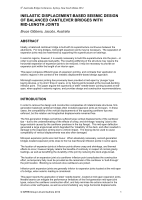Bridges

Inelastic Displacement-Based Seismic Design of Balanced Cantilever Bridges With Mid-Length Joints
- Publication no: ABC-DES604-14
- Published: 22 October 2014
- PDF (free) Download
Ideally, a balanced cantilever bridge is built with its superstructure continuous between the abutments. For long bridges, mid-length expansion joints may be necessary. The separation of expansion joints may be maximised by supporting the superstructure on bearings.In seismic regions, however, it is usually necessary to build the superstructure into the piers in order to provide adequate load-paths. The resulting stiffening of the structure may require the horizontal separation of expansion joints to be reduced; it may be necessary to provide an expansion joint within the length of an interior span.This paper compares different types of expansion jointing, and contrasts their application to seismic regions in the context of the inelastic displacement-based design approach.Mid-length expansion jointing has previously been provided at mid-span by plunger-type keying devices, or by short drop-in spans, or by halving-joints located at the live-load-bending inflexion point. The paper argues for the superiority of steel needle-beam jointing located at mid-span, when applied in seismic regions, and provides design and construction recommendations.
Related publications
ABC2022-110-22
Latest Bridges News
